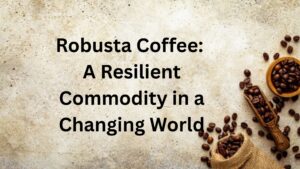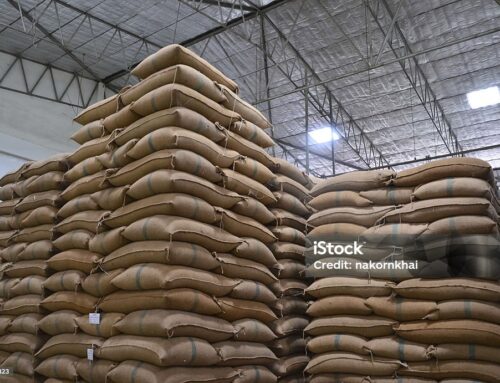
Coffee, a beverage that fuels mornings and sparks conversations across the globe, is more than just a drink; it’s a vital commodity. While Arabica often steals the spotlight with its nuanced flavours, Robusta, the lesser-known but equally significant sibling, plays a crucial role in the global coffee market. Known for its hardiness, high caffeine content, and robust character, Robusta is a powerhouse that underpins much of the world’s instant coffee and espresso blends. This comprehensive exploration delves into the world of Robusta coffee, examining its history, cultivation, market dynamics, and the pressing challenges it faces in an era of climate change and evolving consumer tastes.
Arabica vs. Robusta: A Tale of Two Beans
To truly understand Robusta, it’s essential to first differentiate it from its more famous counterpart, Arabica (Coffea Arabica). These two species dominate the global coffee market, each possessing distinct characteristics that appeal to different palates and serve different purposes.
While Arabica is prized for its nuanced flavours and delicate acidity, Robusta delivers a bolder, more intense taste, contributing to a thicker crema in espresso and offering a higher caffeine kick. Its robustness, as its name suggests, makes it a more forgiving crop to cultivate, particularly in challenging environments.
The History of Robusta Coffee Farming
The roots of Coffea canephora, or Robusta coffee, stretch back hundreds of thousands of years to the humid, understory evergreen forests of central and western sub-Saharan Africa, including regions of Uganda, Congo, and Guinea. For centuries, various forms and ecotypes of Robusta have been cultivated in these warm and humid climates.
However, Robusta’s significant rise as a global commodity is a more recent phenomenon. While Arabica dominated the early coffee trade, the inherent resilience of Robusta began to gain recognition, particularly in the face of widespread coffee leaf rust outbreaks that devastated Arabica plantations in the late 19th and early 20th centuries. The ease of cultivation, higher yields, and resistance to many pests and diseases made Robusta an attractive alternative for farmers seeking more reliable harvests.
The expansion of instant coffee production in the mid-20th century further cemented Robusta’s importance. Its strong flavour and high solubility make it ideal for this application. More recently, the booming demand for espresso, particularly in Europe, has also driven Robusta consumption, as its characteristics contribute to the desired thick crema and intense body of a good espresso shot.
In recent decades, Robusta cultivation has steadily grown, rising from approximately 25% to 40% of total global coffee production since the early 1990s. This growth is driven by increasing global coffee demand, the need for climate-resilient crops, and the expanding market for instant coffee and espresso.
Countries Harvesting Robusta Coffee
Robusta coffee is primarily cultivated in warm, humid climates at lower altitudes. The leading producers of Robusta coffee are:
- Vietnam: Dominates global Robusta production, contributing over 40% of the world’s overall output. Its robust coffee industry has grown exponentially since reforms in 1986.
- Brazil: While known for its Arabica, Brazil is also a significant producer of Robusta, with its climate well-suited for both varieties.
- Indonesia: Ranks among the top global Robusta producers, benefiting from its tropical climate and fertile soil.
- Uganda: As a native region for Robusta, Uganda is a leading African producer, with coffee being a major economic driver.
- India: Primarily grown in the southern states of Karnataka, Kerala, and Tamil Nadu, India is another key contributor to the global Robusta supply.
- Other notable producers include: Malaysia, Tanzania, Thailand, Ivory Coast, and Cameroon.
Risks for Robusta Coffee Farms: Pests and Diseases
Despite its inherent resilience, Robusta coffee farms are not immune to threats. Like any agricultural crop, they face risks from various pests and diseases that can significantly impact yields and quality.
Key Pests:
- Coffee Berry Borer (Hypothenemus hampei): This small beetle is one of the most destructive coffee pests globally. It bores into coffee cherries, consuming the bean and rendering it unsellable. While Robusta plants can exhibit some resistance, infestations can still cause considerable damage.
- Coffee Leaf Miner (Leucoptera coffeella): The larvae of this moth tunnel within coffee leaves, creating characteristic mines that reduce the plant’s photosynthetic capacity, leading to defoliation and reduced vigour.
- Mealybugs: These sap-sucking insects can infest various parts of the coffee plant, weakening it and potentially transmitting viral diseases.
- Nematodes: Microscopic roundworms that live in the soil and attack coffee roots, hindering nutrient uptake and plant growth.
Key Diseases:
- Coffee Leaf Rust (Hemileia vastatrix): While Robusta generally exhibits higher resistance than Arabica, it is not entirely immune to this devastating fungal disease. Leaf rust causes yellow-orange spots on leaves, leading to defoliation, reduced photosynthesis, and ultimately, decreased production. Spores are windborne, making rapid spread a concern, especially in warm, humid conditions.
- Coffee Berry Disease (CBD) (Colletotrichum kahawae): Although primarily a concern for Arabica, some Robusta varieties can be affected. This fungal disease causes lesions on green coffee berries, leading to premature dropping and significant crop loss.
- Cercospora Leaf Spot (Cercospora coffeicola): This fungal disease causes dark brown circular spots on leaves and berries, leading to defoliation and reduced quality. It’s often associated with poor nutrient management or excessive shade.
Mitigation Strategies:
Farmers employ various strategies to manage these risks, including:
- Resistant Varieties: Planting Robusta varieties specifically bred for increased resistance to common pests and diseases.
- Integrated Pest Management (IPM): A holistic approach combining biological control (natural predators), cultural practices (pruning, sanitation), and targeted use of pesticides when necessary.
- Proper Agronomic Practices: Maintaining healthy soil, balanced fertilisation, and appropriate shade levels to boost plant vigour and natural defences.
- Monitoring and Early Detection: Regularly inspecting plants for signs of infestation or disease to allow for timely intervention.
Soil Requirements for Robusta Coffee
Robusta coffee, while more adaptable than Arabica, still thrives in specific soil conditions for optimal growth and yield. Ideal soil characteristics for Robusta cultivation include:
- Good Drainage: Robusta plants are sensitive to waterlogging. Well-drained soils prevent root rot and allow for proper aeration.
- Texture: Loam, sandy loam, or silt loam textures are generally preferred. These soils offer a good balance of water retention and drainage.
- Effective Depth: An effective soil depth of more than 100 cm is beneficial, allowing for strong root development.
- pH Level: Robusta prefers slightly acidic to neutral soils, with an optimal pH range of 5.5 to 6.0.
- Nutrient Content: While robust, the plant still benefits from soils with moderate or higher levels of essential nutrients like Nitrogen (N), Phosphorus (P), and Potassium (K). Regular soil testing and fertilisation are crucial.
- Organic Matter: Soils rich in organic matter improve fertility, water retention, and overall soil health.
- Salinity: Low soil salinity is preferred (less than 1).
- Slope: Gentle slopes (less than 8%) are ideal to minimise erosion and facilitate cultivation.
Countries Consuming the Most Robusta Coffee
While data on specific Robusta consumption by country can be challenging to isolate from overall coffee consumption, the largest coffee-consuming nations worldwide are generally also significant consumers of Robusta, particularly due to its prevalence in instant coffee and espresso.
Key consumers include:
- Brazil: The world’s largest coffee producer and consumer.
- United States is a major importer and consumer of coffee in various forms.
- European Union (particularly Germany, Italy, Spain): These countries have strong traditions of espresso consumption, where Robusta plays a key role. They are also significant importers of Vietnamese Robusta.
- Vietnam: As the largest producer, domestic consumption is also substantial, especially of instant coffee.
- Indonesia: Another major producer with significant domestic consumption.
- Japan: A large consumer of instant coffee.
- Russia: A notable importer of Robusta coffee.
- India: A growing coffee market with increasing consumption of both instant and brewed coffee.
Biggest Importers and Exporters of Robusta Coffee
Largest Exporters of Robusta Coffee:
- Vietnam: Undoubtedly the world’s leading exporter of Robusta coffee, accounting for a massive share of global shipments.
- India: A significant exporter, particularly of its “Cherry Robusta” varieties.
- Indonesia: Another major player in the global Robusta export market.
- Uganda: A key African exporter of Robusta.
- Brazil: While exporting a large volume of Arabica, Brazil also exports substantial quantities of Robusta.
Largest Importers of Robusta Coffee:
The primary destinations for Robusta coffee exports are often countries with large instant coffee industries or a strong preference for espresso blends.
- United States: A major market for all coffee types.
- Germany: A top importer, particularly from Vietnam.
- Italy: Critical for its espresso industry, where Robusta contributes to crema and body.
- Spain: Another significant European importer of espresso and blends.
- Japan is known for its high consumption of instant coffee.
- Russia: A notable importer of Robusta.
- Netherlands: A key European import hub.
Exchanges Trading Robusta Coffee as a Commodity
Robusta coffee is traded as a commodity on international futures exchanges, allowing producers, roasters, and investors to manage price risk and speculate on future prices. The primary exchange for Robusta coffee futures is:
- ICE Futures Europe (formerly LIFFE – London International Financial Futures and Options Exchange): Based in London, ICE Futures Europe offers Robusta coffee futures contracts. These contracts are typically expressed in US dollars per metric ton.
These futures contracts provide a standardised mechanism for buying and selling specified quantities of coffee for delivery at a future date, playing a crucial role in the global pricing and supply chain of Robusta coffee.
Price History of Robusta Coffee
The price of Robusta coffee, like any agricultural commodity, is influenced by a complex interplay of supply and demand factors, geopolitical events, and climate conditions. Analysing its price history reveals periods of relative stability punctuated by significant volatility.
Historically, Robusta prices have generally been lower than Arabica due to its higher yield and ease of cultivation. However, recent years have seen a notable surge in Robusta prices, often outpacing Arabica’s gains. This upward trend is primarily driven by:
- Strong Demand: Increasing global coffee consumption, particularly in emerging markets, and the continued popularity of instant coffee and espresso, are fueling demand for Robusta.
- Supply Concerns: Adverse weather conditions in major Robusta-producing regions, such as droughts in Vietnam and Indonesia, have led to reduced harvests and tighter supply.
- Geopolitical Factors: Disruptions to shipping routes (e.g., the Red Sea conflicts) can increase transportation costs, impacting global prices.
- Speculation: Futures markets are also influenced by speculative trading, which can amplify price movements.
For instance, in April 2024, Robusta prices saw a significant increase, reaching over $4,080 per ton, more than double the quotations from 2023. This surge highlights the sensitivity of the market to supply shocks and robust demand. Prices are typically quoted in USD per metric ton on the ICE Futures Europe exchange. Regular monitoring of historical data (available through financial platforms like Barchart.com and YCharts) reveals monthly fluctuations and long-term trends, with prices generally trending upwards in the face of climate change and rising demand.
How Global Warming is Affecting the Environment for Robusta Coffee
Global warming poses a significant and multifaceted threat to coffee cultivation, including Robusta, despite its perceived resilience. While Robusta can tolerate higher temperatures than Arabica, it is not immune to the impacts of a changing climate.
Key Impacts of Global Warming:
- Increased Temperatures: Even within Robusta’s optimal temperature range (22-30°C), rising temperatures can lead to heat stress, affecting flowering, bean development, and overall plant health. Prolonged extreme heat can reduce yields and quality.
- Altered Rainfall Patterns: Climate change is leading to more erratic and unpredictable rainfall. This can manifest as:
- Droughts: Extended dry periods can severely impact coffee plants, especially during critical growth stages, leading to wilting, reduced fruit set, and increased mortality. Robusta, while drought-tolerant to a degree, still requires consistent water for optimal production.
- Intense Rainfall and Flooding: Conversely, heavy, concentrated rainfall can lead to soil erosion, nutrient leaching, and waterlogging, all of which are detrimental to coffee plants.
- Increased Pest and Disease Pressure: Warmer temperatures and altered humidity levels create more favourable conditions for the proliferation of pests like the coffee berry borer and diseases like coffee leaf rust. Pests and diseases can expand their geographical range and severity, impacting regions previously less affected.
- Shifting Growing Zones: As temperatures rise, existing coffee-growing regions may become less suitable, forcing farmers to consider new, higher-altitude areas. However, the availability of suitable land, infrastructure, and traditional knowledge in these new zones can be limited.
- Extreme Weather Events: Increased frequency and intensity of extreme weather events, such as heatwaves, severe storms, and prolonged droughts, can devastate coffee farms, leading to substantial crop losses and economic hardship for farmers.
- Reduced Water Availability: Changes in rainfall patterns can impact water sources, making irrigation more challenging and expensive, particularly for smallholder farmers.
While Robusta’s hardiness offers some buffer against these impacts compared to Arabica, the magnitude and speed of climate change still present significant challenges for its long-term viability and sustainability.
Suggestions for Farmers to Mitigate the Impact of Global Warming
To ensure the continued resilience and productivity of Robusta coffee farms in the face of global warming, farmers can adopt a range of specific, sustainable practices:
-
Agroforestry and Shade Management:
- Planting Shade Trees: Integrating native shade trees within coffee plantations creates a microclimate that reduces temperature extremes, conserves soil moisture, and protects coffee plants from direct sunlight. Shade trees also improve soil fertility by contributing organic matter and can help with carbon sequestration.
- Optimising Shade Levels: Balancing shade to ensure sufficient light for coffee production while providing protection. Different coffee varieties and local climates may require varying shade densities.
-
Improved Water Management:
- Efficient Irrigation Systems: Implementing drip irrigation or other water-efficient technologies to deliver water directly to the plant roots, minimising waste.
- Rainwater Harvesting: Collecting and storing rainwater for use during dry periods.
- Mulching: Applying organic mulch around coffee plants to reduce evaporation, conserve soil moisture, and suppress weeds.
- Contour Planting and Terracing: On sloped land, planting along contours or constructing terraces helps reduce runoff and soil erosion, improving water infiltration.
-
Soil Conservation and Health:
- Cover Cropping: Planting cover crops between coffee rows to prevent soil erosion, improve soil structure, add organic matter, and suppress weeds.
- Composting and Organic Fertilisers: Enhancing soil fertility and structure by incorporating compost and other organic amendments, reducing reliance on synthetic fertilisers.
- Minimising Tillage: Reducing soil disturbance helps maintain soil structure, organic matter, and microbial health.
- Soil Testing: Regular soil analysis to ensure balanced nutrient levels and efficient fertiliser application.
-
Diversification and Genetic Improvement:
- Planting Climate-Resilient Varieties: Utilising Robusta varieties that are specifically bred or naturally possess higher tolerance to heat, drought, and prevalent diseases.
- Crop Diversification: Intercropping coffee with other compatible crops (e.g., fruit trees, food crops) to create a more diversified income stream, reduce risk, and improve ecosystem health.
-
Integrated Pest and Disease Management (IPM):
- Biological Control: Introducing or conserving natural predators of pests.
- Disease-Resistant Clones: Selecting and planting Robusta clones known for their resistance to specific diseases.
- Timely Pruning and Sanitation: Removing diseased or infested plant parts to prevent spread.
- Monitoring: Regular scouting for pests and diseases to enable early intervention.
-
Carbon Sequestration Initiatives:
- Agroforestry: As mentioned, shade trees in agroforestry systems sequester carbon, contributing to climate change mitigation.
- Sustainable Land Management: Practices that enhance soil organic carbon, turning farms into carbon sinks.
-
Farmer Education and Support:
- Knowledge Transfer: Providing farmers with training and access to information on climate-smart agricultural practices.
- Access to Finance: Supporting farmers in investing in sustainable technologies and practices.
- Market Linkages: Connecting farmers with markets that value sustainably produced coffee, potentially offering premium prices.
By implementing these practices, Robusta coffee farmers can build more resilient farming systems, reduce their environmental footprint, and secure their livelihoods in a changing climate.
The New Age of Coffee Consumption and Its Effect on Robusta Coffee
The “new age” of coffee consumption, often characterised by the rise of speciality coffee culture, a focus on single-origin beans, unique brewing methods, and a desire for transparency and ethical sourcing, has traditionally favoured Arabica coffee. Arabica’s complex flavour profiles and diverse notes align well with the connoisseur’s pursuit of nuanced taste experiences.
However, Robusta is increasingly finding its place within this evolving landscape, albeit with some interesting shifts:
- Speciality Robusta: There’s a growing movement towards recognising and cultivating “speciality Robusta.” Farmers and roasters are focusing on improved cultivation, harvesting, and processing methods to enhance Robusta’s inherent characteristics and minimise undesirable bitter or rubbery notes. This involves meticulous cherry selection, controlled fermentation, and careful roasting. High-quality Robusta can exhibit notes of chocolate, nuts, and dark spices, with a full body and excellent crema, appealing to a segment of the speciality market.
- Espresso Culture: The enduring popularity of espresso, particularly in European markets, continues to be a significant driver for Robusta. Robusta’s ability to produce a rich, dense crema and add body to espresso blends is highly valued. Many premium espresso blends incorporate a percentage of high-quality Robusta for these specific attributes.
- Cold Brew and Other Formats: The robust flavour and higher caffeine content of Robusta make it a suitable candidate for cold brew, where its strong character can shine through without excessive bitterness when properly prepared. It’s also finding its way into various ready-to-drink (RTD) coffee products and coffee-based confections.
- Cost-Effectiveness and Blending: As global demand for coffee rises and climate change puts pressure on Arabica supplies, Robusta’s cost-effectiveness and versatility in blending remain crucial. It allows roasters to create more affordable yet flavorful coffee products, making coffee accessible to a wider consumer base.
- Sustainability and Resilience: In an era where sustainability and climate resilience are paramount, Robusta’s inherent hardiness and ability to thrive in warmer, lower-altitude environments are becoming increasingly attractive. Consumers and industry players are recognising the need for diverse coffee portfolios that can withstand environmental shocks.
While Arabica still holds the prestige in the speciality world, Robusta is shedding its “inferior” image. The new age of coffee consumption is pushing innovation in Robusta production, leading to better quality beans and a broader appreciation for its unique contribution to the coffee experience.
Specific Characteristics that Differentiate Arabica from Robusta in terms of Flavor and Cultivation
Flavour Differentiations:
-
Arabica:
- Complexity: Offers a wider spectrum of flavours, ranging from sweet and fruity (berries, citrus) to floral, chocolatey, caramel, and nutty notes.
- Acidity: Higher acidity, which, when properly roasted, contributes to a bright, vibrant, and complex cup.
- Aroma: Generally more aromatic and fragrant, often described as having distinct floral or fruity scents.
- Body: Tends to have a lighter to medium body.
- Aftertaste: Typically cleaner and more pleasant, without lingering bitterness.
-
Robusta:
- Boldness/Intensity: Characterised by a strong, full-bodied taste.
- Bitterness: Higher levels of bitterness due to its higher caffeine and chlorogenic acid content. This can be desirable for some applications (e.g., espresso) or masked by roasting.
- Earthy/Rubbery Notes: Lower quality Robusta can exhibit distinct earthy, woody, or even rubbery/burnt tire notes. High-quality Robusta, however, can showcase chocolatey, nutty, and even spicy undertones.
- Crema: Produces a thick, persistent crema in espresso, which is highly prized in Italian-style coffee.
- Body: Tends to have a heavier, fuller body.
Cultivation Differentiations:
-
Arabica:
- Altitude: Requires high altitudes (typically 800-2500 meters above sea level). These elevated regions provide cooler temperatures and distinct day/night temperature fluctuations, crucial for slow bean development and flavour complexity.
- Temperature: Prefers consistent moderate temperatures (16-24°C). Sensitivity to frost and extreme heat.
- Rainfall: Needs consistent, well-distributed rainfall (around 1500-2000 mm annually), with distinct wet and dry seasons.
- Soil: Thrives in rich, well-drained volcanic soils.
- Pest/Disease Resistance: More susceptible to pests (like coffee berry borer) and diseases (especially coffee leaf rust), requiring more intensive management.
- Growth: Slower growing, takes longer to mature, and produces lower yields per plant. Often requires more manual labour due to growing on slopes.
-
Robusta:
- Altitude: Thrives in lower altitudes (generally below 800 meters above sea level), including flat plains.
- Temperature: Tolerates hotter temperatures (22-30°C) and can withstand more fluctuating conditions.
- Rainfall: Adaptable to varying rainfall patterns, though consistent rainfall is still beneficial. More resilient to drought.
- Soil: Less demanding regarding soil type, though well-drained, fertile soils are still ideal.
- Pest/Disease Resistance: Significantly more resistant to many common coffee pests and diseases, particularly coffee leaf rust, due to its higher caffeine and chlorogenic acid content.
- Growth: Faster growing, matures earlier, and produces higher yields. Its growth habit often allows for more mechanised cultivation.
These fundamental differences in flavour and cultivation are why Arabica and Robusta often occupy different market segments and serve complementary roles in the global coffee industry.
How Farmers Can Implement Sustainable Practices to Combat Climate Change in Robusta Coffee Production
Implementing sustainable practices is no longer an option but a necessity for Robusta coffee farmers to combat climate change and ensure the long-term viability of their livelihoods. Building upon the general mitigation strategies, here’s how farmers can specifically apply them in Robusta production:
-
Enhancing Soil Health for Resilience:
- Biochar Application: Incorporating biochar (charcoal produced from biomass) into the soil can significantly improve water retention, nutrient availability, and carbon sequestration, making soils more resilient to drought and heavy rainfall.
- Compost and Manure Use: Regularly applying compost and animal manure builds organic matter, which enhances soil structure, microbial activity, and water-holding capacity. This is crucial for Robusta in hotter, drier conditions.
- Terracing and Contour Farming: On sloped land, creating terraces and planting along contours prevents soil erosion caused by intense rainfall and helps retain precious topsoil and moisture.
-
Optimising Water Use and Management:
- Drip Irrigation Systems: While Robusta is more drought-tolerant, supplemental irrigation during dry spells is critical for maximising yields. Drip irrigation minimises water waste by delivering water directly to the root zone.
- Rainwater Harvesting and Storage: Constructing ponds or underground tanks to collect rainwater during wet seasons for use during droughts.
- Shade Management with Native Trees: Strategically planting native, drought-tolerant shade trees (e.g., nitrogen-fixing legumes) reduces evapotranspiration from coffee plants, keeping the soil cooler and moister. This creates a microclimate that benefits Robusta.
- Mulching with Crop Residues: Using coffee pulp, leaves, or other organic matter as mulch around the base of plants reduces evaporation, controls weeds, and slowly releases nutrients.
-
Biodiversity and Agroforestry for Ecosystem Services:
- Diverse Shade Systems: Moving beyond monoculture, farmers can establish diverse agroforestry systems with multiple layers of vegetation. This enhances biodiversity, attracts natural predators for pests, and provides additional income streams (e.g., fruit trees, timber).
- Native Species Integration: Prioritising native trees and plants in shade systems supports local ecosystems and wildlife, contributing to overall farm health and resilience.
- Pest Management through Habitat Creation: Promoting natural pest control by creating habitats for beneficial insects and birds, reducing reliance on chemical pesticides.
-
Resilient Varietal Selection and Crop Diversification:
- Climate-Adapted Robusta Clones: Collaborating with research institutions to identify and plant Robusta clones that exhibit superior performance under specific local climate change scenarios (e.g., higher heat tolerance, drought resistance, or specific disease resistance).
- Intercropping with Drought-Tolerant Crops: Diversifying farm income by intercropping with drought-resistant food crops or other cash crops that can withstand changing conditions, reducing dependence on a single crop.
-
Energy Efficiency and Waste Reduction:
- Renewable Energy: Exploring solar power for farm operations, such as pumping water for irrigation or powering processing equipment.
- Biogas Production: Utilising coffee pulp and other organic waste to produce biogas for cooking or energy, reducing reliance on fossil fuels and minimising waste.
- Efficient Processing: Adopting water-efficient processing methods (e.g., dry processing or eco-pulping) to conserve water and reduce pollution.
-
Knowledge Sharing and Farmer Collaboration:
- Farmer Field Schools: Participating in or organising farmer field schools to share best practices, learn about new climate-smart techniques, and adapt to local conditions.
- Access to Climate Information: Using weather forecasts and climate advisories to make informed decisions about planting, irrigation, and pest management.
- Certification and Fair Trade: Pursuing sustainability certifications (e.g., Rainforest Alliance, UTZ, Fair Trade) that often promote climate-smart practices and can lead to better market access and premiums for farmers.
By embracing these specific sustainable practices, Robusta coffee farmers can transform their operations into more resilient, environmentally friendly, and economically stable enterprises, ensuring a future for this vital commodity.
What Role Do Consumer Trends and Preferences Play in Shaping the Future Market for Robusta Coffee?
Consumer trends and preferences are powerful forces that profoundly shape the future market for Robusta coffee. While Robusta has historically been the workhorse of the instant coffee and espresso industry, evolving consumer awareness and desires are pushing the commodity in new directions.
-
Demand for Sustainable and Ethical Sourcing:
- Traceability and Transparency: Consumers, especially in developed markets, increasingly want to know the origin of their coffee, how it was grown, and that farmers were paid fairly. This drives demand for certified Robusta (e.g., Fair Trade, Rainforest Alliance) and pushes producers to adopt more transparent supply chains.
- Environmental Impact: Growing concern about climate change and deforestation is leading consumers to seek coffee produced with minimal environmental impact. Robusta’s potential for climate resilience and its role in agroforestry systems could become a selling point.
- Social Equity: A focus on fair labor practices and community development within coffee-producing regions influences purchasing decisions.
-
The Rise of Speciality and Quality Robusta:
- Flavour Exploration: While Arabica dominates speciality coffee, a segment of consumers and roasters are exploring the unique flavour attributes of high-quality Robusta. This trend, driven by “third wave” coffee culture, seeks to differentiate and elevate Robusta’s profile, leading to new product development (e.g., single-origin robusta, specific processing methods).
- Espresso and Brewing Method Versatility: The consistent demand for rich, full-bodied espresso continues to underscore Robusta’s importance. Its higher caffeine content also appeals to consumers seeking a stronger “kick,” particularly in iced coffees or pre-made coffee beverages.
-
Health and Wellness Trends:
- Caffeine Content: Robusta’s higher caffeine content appeals to consumers seeking energy boosts or specific health benefits associated with caffeine, such as enhanced physical performance.
- Antioxidant Properties: Research highlighting Robusta’s high antioxidant content (due to higher chlorogenic acid) could become a marketing advantage as consumers become more health-conscious.
-
Convenience and Innovation:
- Instant Coffee and RTD: The enduring popularity of instant coffee and the explosive growth of ready-to-drink (RTD) coffee beverages remain significant drivers for Robusta demand. Consumers prioritise convenience, and Robusta is well-suited for these mass-market applications due to its solubility and strong flavour.
- New Product Formats: Robusta’s versatility allows for innovation in coffee products, from coffee pods and capsules to coffee-infused snacks and drinks.
-
Price Sensitivity in Blends:
- Affordability: For a large segment of the market, price remains a key factor. Robusta’s generally lower cost compared to Arabica allows roasters to create more affordable coffee blends, catering to budget-conscious consumers, especially in emerging economies.
- Balancing Quality and Cost: Roasters can use Robusta to provide body and crema while blending with Arabica for flavour complexity, striking a balance between cost and desired taste profiles.
In essence, consumer trends are pushing Robusta coffee to evolve beyond its traditional role. The future market will likely see a bifurcated demand: continued strong demand for mass-market applications (instant, value blends) and a growing, albeit smaller, market for premium, sustainably sourced, and speciality Robusta, driven by a more discerning and environmentally conscious consumer base. This shift will incentivise farmers and the industry to invest in better cultivation, processing, and marketing of Robusta, elevating its status in the global coffee landscape.




